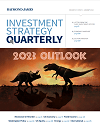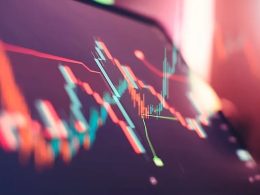by Larry Adam, Chief Investment Strategist, Raymond James
On the 80th anniversary of the iconic movie’s release, CIO Larry Adam draws parallels between the film’s themes and today’s financial markets.
The state of the economy is paramount in determining the return potential of the major asset classes. We forecast that U.S. gross domestic product will grow 2.2% in 2019 and 1.7% in 2020, averting a recession through at least the 2020 presidential election. Dorothy’s companions’ search for a brain, a heart and courage frame our optimistic outlook.
Our brain relies on the facts, and although there has been a spike in recessionary fears, the data we observe (such as leading economic indicators, real-time activity metrics, employment conditions and history) points to an extension of this record-setting economic expansion. While many pessimists point to the yield curve inversion, inversions historically precede a recession by approximately 22 months.1
The U.S. consumer is the heart of both the U.S. and global economy. Collectively, U.S. consumers represent approximately 70% of the U.S. economy, and U.S. consumption is greater than the economies of Japan, Germany and the U.K. combined.1 With healthy job creation, rising wages and high consumer confidence, this heart should continue pumping.
Business spending is the next largest component of the economy. For the economy to grow more rapidly, businesses will need to find the courage to deploy investment capital and reverse the decline we’ve seen recently.
In this real-life rendition, investors seek guidance from two wonderful wizards – President Trump and Federal Reserve (Fed) Chairman Powell. Trade frictions are beginning to weigh on the economy as a recent poll2 suggested that, for the first time since President Trump took office, more respondents believe the economy is getting worse rather than better. The full implementation of a third tranche of tariffs (on $300 billion of Chinese imports) will squarely affect the consumer. With a presidential election looming, it’d be detrimental to increase consumer costs and potentially send the economy into a tailspin. As a result, this last tranche will likely be postponed or not fully implemented if a deal isn’t secured. With the Fed, it’s simple: it will cut interest rates enough to maintain the momentum of this economic expansion. The specific number of cuts is of less importance. As long as the economy does not fall into a recession, riskier assets like equities should move higher.
The wicked witches that need to be watched include oil prices and the dollar. We estimate that the consumer can absorb oil prices up to $70/barrel (our base case), as that keeps gasoline prices below the psychologically important $3/gallon level. However, festering geopolitical risks from the Middle East and new International Maritime Organization sulfur regulations could place upward pressure on oil prices. In the west, the race to the bottom with interest rates has caused declines in many currencies like the euro. With the dollar at its highest level since May 2017, concerns are mounting that it is hampering the competiveness of U.S. exports. However, our forecast is that the dollar will stabilize over the next year, alleviating some pressure on the U.S. economy.
As for the bond market, we are not in Kansas anymore. Fundamental factors (such as domestic economic growth and inflation) that traditionally dictate the level and direction of interest rates are overshadowed by massive global central bank bond purchases and global growth fears. With a record level of negative-yielding debt, many roads lead to the U.S. bond market when it comes to the search for positive yield. In some countries, such as Germany, the entire yield curve is negative. With international investors seeking positive yields and baby boomers adjusting their portfolios to include more exposure to bonds, the extra demand for U.S. Treasuries should keep U.S. rates lower for longer. Our 12-month forecast for the 10-year Treasury yield is 1.40%.
In the credit space, the best annual start in more than 20 years has narrowed spreads and made these bonds less attractive. We favor investment-grade bonds and emerging-market bonds over high-yield bonds, which, at current yields, do not adequately compensate investors for their level of risk.
Our belief that there’s no place like home favors U.S. equities over other developed countries. While international markets may temporarily outpace U.S. equities on the expectation of more monetary and fiscal stimulus, we remain skeptical, as the effects from previous policy stimulus have not yielded sustainable momentum. Our 12-month forecast for the S&P 500 of 3,122 is predicated on a favorable economic backdrop, positive earnings growth, attractive valuations and supportive seasonality factors. Within the U.S., we reiterate our preference of large cap over small cap. For less risk averse investors, emerging market equities are attractive but remain dependent upon the outcome of the trade dispute.
Currently, President Trump’s tweets, a divided Fed, recessionary fears, Brexit and Iran are causing elevated uncertainty and turbulence. History suggests that trying to time these types of events often results in poor, emotionally-driven decisions. Thus, regardless of the daily noise, successful investors follow a well-thought out financial plan – much like Dorothy followed the yellow brick road. The road’s bricks include assessing your asset allocation, investment objectives and risk tolerance, selecting appropriate investment vehicles, and periodically reviewing your portfolio with your advisor. So before making a hasty portfolio change, remind yourself that having a disciplined investment strategy is the most likely path to realizing your financial goals somewhere over the rainbow.

Read the full October 2019
Investment Strategy Quarterly
2 Pew Research Center
All expressions of opinion reflect the judgement of Raymond James & Associates, Inc., and are subject to change. There is no guarantee that these statements, opinions or forecasts provided herein will prove to be correct. Any information is not a complete summary or statement of all available data necessary for making an investment decision and does not constitute a recommendation. Investing in international securities involves additional risks such as currency fluctuations, differing financial accounting standards, and possible political and economic instability. These risks are greater in emerging markets. Companies engaged in businesses related to a specific sector are subject to fierce competition and their products and services may be subject to rapid obsolescence. Asset allocation does not guarantee a profit nor protect against loss. The S&P 500 is an unmanaged index of 500 widely held stocks that is generally considered representative of the U.S. stock market. Keep in mind that individuals cannot invest directly in any index, and index performance does not include transaction costs or other fees, which will affect actual investment performance. Bond prices and yields are subject to change based upon market conditions and availability. If bonds are sold prior to maturity, you may receive more or less than your initial investment. There is an inverse relationship between interest rate movements and fixed income prices. Generally, when interest rates rise, fixed income prices fall and when interest rates fall, fixed income prices rise.
Copyright © Raymond James
















